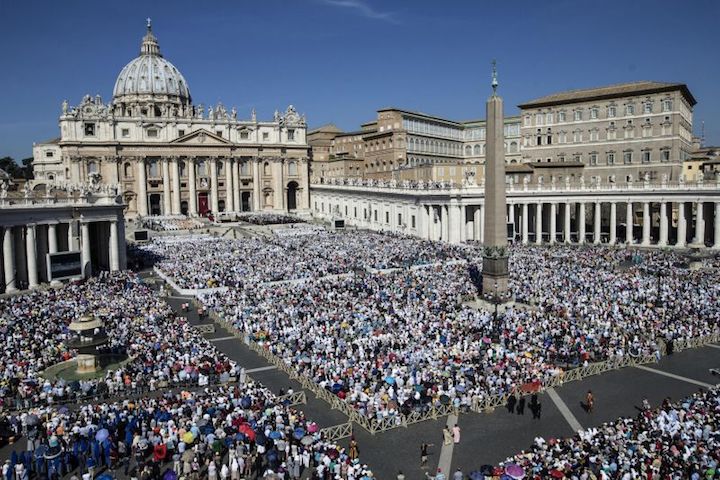Rather than absorbing the disparaging popular image of Catholicism, let’s take some vigorous steps to learn – and even to relish – the notable contributions Catholicism has made to world civilization for millennia. We might even share it with our kids.
Imagine if we could walk through a museum showing some of the great Catholic achievements in world history. This would be much more honest than going along with the massive propaganda efforts of the Enlightenment to suppress this remarkable history. Thomas E. Woods’ book How the Catholic Church Built Western Civilization offers a tantalizing picture of just some of the thousands of world-changing contributions that Catholics have made over the centuries.
Let’s start with astronomy. Woods says “the Roman Catholic Church gave more financial aid and social support to the study of astronomy for over six centuries from the recovery of ancient learning during the late Middle Ages into the Enlightenment, than any other and probably all other institutions.” He was quoting the conclusion of a researcher at the University of California, Berkeley.
Looking at the building of European culture, he calls Saint Benedict “the Father of Europe” because of the whole range of institutions and charitable works done by Benedictine monasteries through the ages. They range from centers for animal husbandry and farming to centers of learning and libraries. And don’t forget the worship.
Of course, there were innumerable other contributions in the cultural arena. A Dominican priest, Francisco de Vitoria (born 1483), is often called the Father of International Law for his arguments about the legal status of the peoples of the New World. He argued that the natural law “existed not just among Christians but among all peoples.”

One of the most extensive and least appreciated contributions of Catholicism, Woods addresses under the expansive chapter heading, “How Catholic Charity changed the World.” Woods starts with the experience of a pagan Roman soldier, Pachomius in the fourth century. When the plague hit the Emperor Constantine’s army, Pachomius was surprised to see that his fellow soldiers were bringing suffering people food and aid. When he asked them, he discovered that they were Catholics.
Woods traces the charitable developments through the centuries, mentioning things like the massive hospice in Jerusalem that started as an aid station for pilgrims, but by the twelfth century was looking more like a modern hospital specifically caring for the sick and doing simple operations. It served Muslims and Jews as well. According to a visiting priest at the time: “we could in no way judge the number of people who lay there but we saw a thousand beds.” The massive Catholic charitable services today have truly heroic antecedents.
Universities: “it is to the Middle Ages that we owe one of civilization’s greatest – unique – intellectual contributions to the world: the university system.” True, but that legacy is threatened, even at Catholic institutions of higher learning. Pope John Paul II felt obliged to issue Ex Corde Ecclesiae (1990) to pull Catholic universities out of their obsession with Enlightenment-style thinking. Advocates of the Enlightenment thought and still think that they started universities and are the only ones who understand what reason is all about. John Paul II had to issue Fides et ratio, a couple of years later, to remind people what the Church had always known about the proper use of reason, which he describes as, properly speaking, having “true metaphysical reach.”
Once we free ourselves from the information suppression program of the Enlightenment and its many modern adherents, the true image of the Catholic Church stands out proudly. This shouldn’t lead to the Church adopting the mirror image of Enlightenment arrogance, but instead to shaking off its almost apologetic public presence in America.
From the lack of meaty articles in diocesan newspapers, to our largely invisible bishops who, instead, ought to be teaching the nation, to the mostly unteaching clergy to the largely uninformed laity, there is massive educational inertia. One area particularly neglected is the number of religious sisters who don’t have much college-level training in the faith. This is strange when so much money is spent on training clergy.
A good way to approach the situation would be to ask why so many Catholics know so little about the glorious institution in which they participate? Catholics must strive consciously, on a daily basis, to participate in the Catholic culture that is part of the life of faith. This is a two-way street. Faith becomes richer and easier when we have regular exposure to great Catholic music, for example. And listening to such music pushes back against the incessant intrusion of secular music into public spaces. Or we might look to the art. Just familiarizing yourself with the stained-glass work of Moira Forsyth (1905-1991) alone, the former English President of the Society of Catholic Artists, would richly repay study.
Entering Catholic culture is an incremental process. It involves sacraments and community, charitable activities, as well as what we usually think of as culture: novels, plays, music, architecture, the arts and the sciences. It’s all just waiting to be discovered. And the more you know it and appropriate it in your life, the more you can manifest it to the world.
This is what Christ brought us – and what we need to bring to others.















